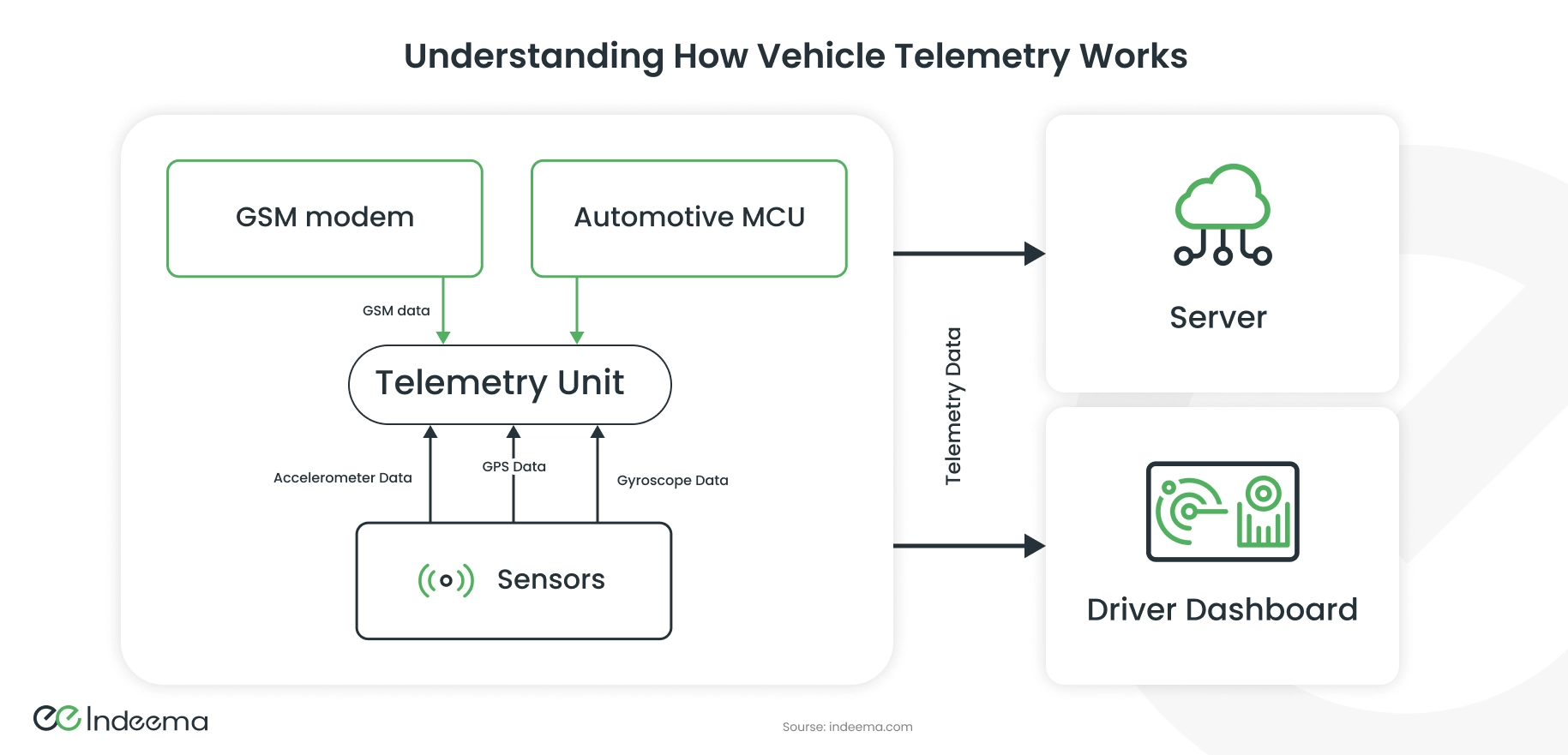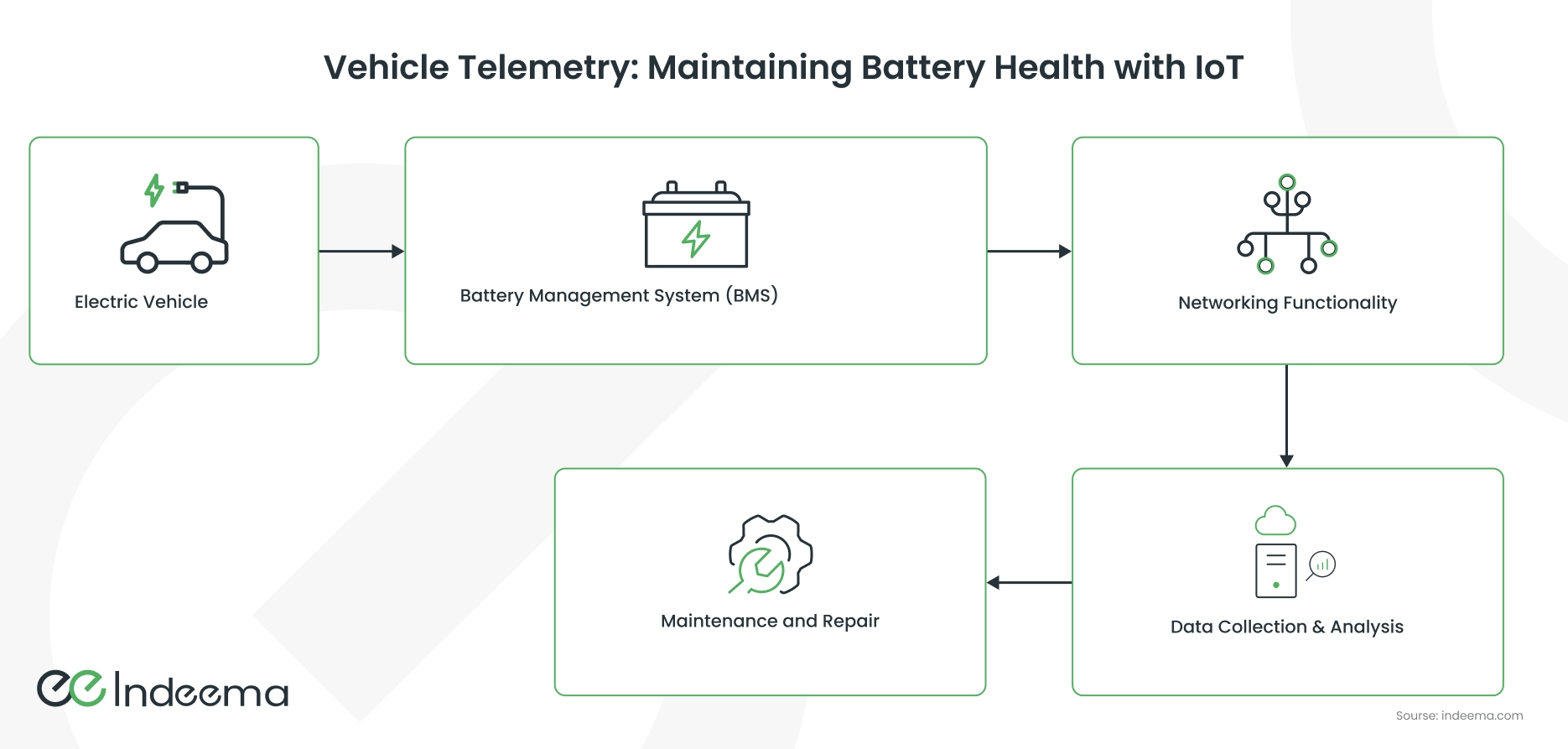Introduction: What's Telemetry in Vehicles?
In the vast realm of automotive technology, there exists a fascinating concept known as telemetry.
In simple terms, vehicle telemetry is the art and science of collecting, transmitting, and analyzing data from moving vehicles. This data encompasses a broad spectrum, ranging from engine performance and fuel efficiency to driver behavior and environmental conditions. Telemetry equips vehicles with the ability to communicate their status and operational parameters in real-time, transforming them into data-driven entities. This transformative technology has paved the way for a multitude of benefits, revolutionizing various aspects of our daily lives.
From traditional cars to electric motorcycles, our article explores the diverse applications of vehicle telemetry, with telemetry explained to showcase its versatility in the world of transportation. We'll demystify its definitions, explore the myriad advantages it offers, and confront the formidable challenges it poses. By the end, you'll have a clear understanding of how telemetry is shaping the future of transportation and why it's a topic that deserves your attention. So, fasten your seatbelts as we embark on this journey into the fascinating realm of vehicle telemetry. You can also look at how IoT is used in the military.
1. Understanding How Telemetry Works
Understanding what a telemetry system is unlocks a world of possibilities for enhancing vehicle performance and safety. To put it simply, telemetry in the context of automobiles is a technological marvel that powers the transportation industry of today. But how does telemetry work its magic? Let's dive into the mechanics.

At its core, telemetry involves the seamless exchange of data between a vehicle and a central system. Here's the step-by-step breakdown:
- Data Collection: Sensors embedded in the vehicle continuously gather data. These sensors monitor various aspects like engine performance, speed, fuel consumption, tire pressure, and even driver behavior.
- Data Transmission: The collected vehicle telemetry data is then transmitted in real-time using wireless technology. This could be through cellular networks, satellite connections, or dedicated short-range communication (DSRC) systems.
- Centralized System: The transmitted data is received by a centralized system, which can be located remotely. This system processes and stores the information in a secure database.
- Data Analysis: Data analysts and algorithms work their magic to make sense of the incoming data. They can generate insights into vehicle health, driver behavior, and more.
- Feedback Loop: Relevant stakeholders, such as fleet managers, vehicle owners, or even the drivers themselves, receive actionable insights. This feedback loop empowers them to make informed decisions, optimize performance, and enhance safety.
Telemetry's beauty lies in its versatility. It caters to a wide range of applications, from tracking a delivery van's route in real-time to providing diagnostics for a Formula 1 race car. Now that we have a grasp of the concept of "What is vehicle telemetry data?", we can delve into the practical applications and benefits of telemetry for cars and motorcycles.
2. What Can Telemetry Measure?
Telemetry is a data-driven powerhouse, capable of measuring a diverse array of parameters within vehicles. So what does telemetry measure in the world of automotive engineering?
- Engine Performance: Telemetry monitors engine RPM (Revolutions Per Minute), temperature, oil pressure, and other critical metrics, ensuring optimal performance and early detection of issues.
- Fuel Efficiency: It tracks fuel consumption, helping drivers and fleet managers optimize routes and reduce costs.
- Vehicle Speed: Telemetry can gauge a vehicle's speed in real-time, promoting safe driving practices and adherence to speed limits.
- Braking and Acceleration: It measures braking intensity and acceleration patterns, contributing to safer and more fuel-efficient driving.
- GPS Location: Telemetry systems incorporate GPS data to pinpoint a vehicle's location, facilitating navigation and real-time tracking.
- Environmental Conditions: Telemetry sensors can detect ambient temperature, humidity, and even air quality, which is crucial for certain applications like transportation of sensitive goods.
- Tire Pressure: Monitoring tire pressure ensures proper tire maintenance, enhances safety, and improves fuel efficiency.
- Driver Behavior: Telemetry evaluates driver behavior, including harsh braking, sharp turns, and idling time. This data promotes safer and more efficient driving practices.
- Vehicle Diagnostics: It conducts comprehensive diagnostics, identifying potential issues before they become major problems, reducing maintenance costs.
- Emission Levels: Telemetry can measure and report vehicle emissions, contributing to environmental awareness and compliance with emissions regulations.
- Battery Health: For electric and hybrid vehicles, telemetry keeps tabs on battery health, ensuring optimal performance and longevity.
- Cargo Monitoring: In logistics, telemetry can measure cargo conditions such as temperature and humidity, guaranteeing the integrity of transported goods.
- Security: Some telemetry systems monitor security via features like intrusion detection, tracking stolen vehicles, and remote vehicle immobilization.
Data for Research: Telemetry generates valuable performance data for research purposes, helping manufacturers improve vehicle designs and contributing to transportation studies.
The versatility of telemetry in measuring these parameters makes it a cornerstone of modern vehicle management, offering benefits ranging from enhanced safety and efficiency to reduced environmental impact.
3. Сar telemetry
Car telemetry, at its core, is the art and science of gathering, transmitting, and interpreting data from a vehicle in real-time. This data encompasses a spectrum as wide as the road itself, capturing intricate details of the vehicle's performance, status, and surroundings.
3.1 Unveiling the Essence of Car Telemetry
Imagine if your car could be a digital storyteller, using sensors placed strategically throughout its mechanical and electronic systems to communicate important information. These sensors are responsible for monitoring a wide range of things, including engine parameters, fuel efficiency, tyre pressure, and environmental conditions. The data obtained is a harmonious blend of insights that offers a complete perspective on the health and performance of your vehicle.
3.2 From Data to Decision: The Telemetry Journey
The process of car telemetry starts with collecting data. Discreetly positioned sensors throughout the vehicle continuously gather information. This data, similar to a digital heartbeat, is then sent wirelessly to a centralised system, which is often located remotely.
Here, the data transforms into actionable insights. Highly skilled data analysts and advanced algorithms analyse the information, revealing patterns, anomalies, and trends. The result is a valuable collection of knowledge that can provide information to drivers, fleet managers, and automotive engineers.
3.3 The Road Ahead: Telemetry's Impact
Car telemetry is not just an impressive technological feat; it serves as a catalyst for revolutionary changes in the automotive industry. It promotes safety by notifying drivers of potential issues before they become more serious. It promotes efficiency by optimising routes and minimising fuel consumption. It promotes environmental responsibility by monitoring emissions and encouraging eco-friendly driving habits. Car telemetry is ready and set to revolutionise your understanding of what is achievable on the open road.
4. Vehicle Telemetry for Electro Motorcycles: Revolutionizing E-Mobility
A major advancement in technology is on the horizon for electric motorcycles, the pinnacle of eco-friendly and exhilarating two-wheeled travel. E-motorcycles are not only environmentally friendly, but also highly intelligent thanks to the incorporation of vehicle telemetry.
4.1 The Data-Powered E-Motorcycle Journey
Think of your electric motorcycle as more than just a means of transportation; picture it as a cutting-edge riding companion. E-motorcycle telemetry achieves this by monitoring and providing insights into various facets of your ride:
- Battery Performance: Detailed information on your motorcycle's battery health, charge level, voltage, and range estimation, ensuring you're always in the know about your power reserves.

- Motor Efficiency: Real-time monitoring of your electric motor's performance, including power output, torque, and thermal conditions, for a seamless and responsive ride.
- Speed and Acceleration: Precise measurements of your speed, acceleration, and throttle input, enabling you to fine-tune your riding style for efficiency and safety.
- Navigation and Route Planning: GPS navigation with route optimization to help you find the most exhilarating or practical paths, whether for daily commuting or adventurous escapes.
- Prevention of Security Incidents: Features like collision detection, emergency response integration, and real-time tire pressure monitoring for an added layer of rider security.
- Emissions Reduction: Tracking your reduction in carbon emissions by choosing electric power over traditional gasoline alternatives.
5. Challenges in Vehicle Telemetry Development
While there are many benefits to vehicle telemetry, there are also some development challenges to overcome. As this technology develops, it will inevitably run into issues that will require creative answers.
Here, we explore some of the key challenges faced in the development of vehicle telemetry systems:
1. Data Security and Privacy: Due to the sensitive nature of the data being transmitted, protecting telemetry data from cyber threats and safeguarding user privacy has become a top priority. It remains a constant challenge to create reliable means of encryption and authentication.
2. Standardization: The diversity of vehicles and telemetry systems requires standardized protocols for seamless data exchange. Achieving industry-wide standards that cater to different vehicle types is a complex task.
3. Data Accuracy and Reliability: Telemetry data must be accurate and reliable for informed decision-making. Ensuring precise data collection, even in adverse conditions, poses a technical challenge.
4. Power Management: Balancing the power demands of telemetry devices with the vehicle's electrical system is essential. Developing efficient power management solutions that minimize battery drain remains a challenge, especially for electric vehicles.
5. Scalability: Telemetry systems must not only adapt to various vehicle types and sizes but also leverage new technologies like artificial intelligence to design scalable solutions that efficiently cater to diverse automotive needs while remaining cost-effective.
6. Real-Time Processing: Processing and analyzing telemetry data stream in real-time is crucial, particularly for applications like autonomous vehicles. Developing high-speed data processing capabilities is an ongoing endeavor.
7. Integration with Legacy Vehicles: Retrofitting older vehicles with telemetry systems can be challenging due to compatibility issues with existing hardware and software. Finding cost-effective solutions for these vehicles remains a challenge.
8. Regulatory Compliance: Telemetry systems must comply with various regional and industry-specific regulations. Staying abreast of evolving regulations and adapting telemetry systems accordingly is a persistent challenge.
9. Environmental Factors: Telemetry devices are exposed to a wide range of environmental conditions, from extreme temperatures to vibrations. Designing robust hardware that can withstand these conditions is a technical hurdle.
10. User Acceptance: Convincing vehicle owners and users of the benefits and safety of telemetry systems can be a challenge, especially in cases where data collection might be seen as intrusive.
Despite these challenges, the development of vehicle telemetry systems continues to advance, driven by the promise of enhanced safety, efficiency, and convenience. Overcoming these obstacles is essential to unlock the full potential of telemetry technology in the automotive industry.

To delve deeper into the real-world application of intelligent vehicle telemetry, we invite you to explore our case study: "Intelligent Vehicle Telemetry for Electric Bikes." Indeema collaborated with an electric bike manufacturer for over six months to develop a telemetry unit that helps them monitor their fleet's performance and travel patterns. This case study offers a firsthand look at how telemetry technology is transforming electric biking, providing insights into the challenges faced and the innovative solutions implemented.
Conclusion
In conclusion, the exploration of vehicle telemetry in this article has shed light on its significance and transformative potential in the automotive industry. Telemetry, as a powerful data-driven automation tool, enables us to monitor and optimize various aspects of vehicle performance, from traditional cars to cutting-edge electric motorcycles, fostering advancements in safety, efficiency, and environmental sustainability.
Car telemetry has long been a cornerstone in enhancing vehicle performance, while its extension into the world of electric motorcycles marks a pioneering leap toward transforming e-mobility.
Need Qualified Help With An IoT-Enabled Project?
Our experts in the relevant fields can assist you in developing a customized solution that will meet all of your company's needs.


